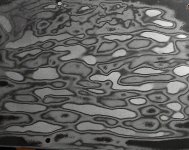I really like to veneer my speakers this way , With that mirror finish . Anyone knows what kind of veneer is this and how to achive this mirror finish ?
An externally hosted image should be here but it was not working when we last tested it.
My guess is that it isn't veneer. Looks like a paint technique where successive layers of different colour paint is applied and once it is dry, they sand through some layers to get that effect.
The mirror finish is many coats of clear (either lacquer or polyurethane) then polished with polishing compound and a buffer.
The mirror finish is many coats of clear (either lacquer or polyurethane) then polished with polishing compound and a buffer.
What speakers are they? They look like something Sonus Faber would produce, in which case that will be a wood veneer at the very least, if not solid wood 🙂
Like John says, lots of layers of lacquer 😉
Like John says, lots of layers of lacquer 😉
It's hard to be sure from the photos, but from the way that the grain structure seems to wrap round the edges, it might be a technique called dip print. They're obviously not carved from a solid block of wood, so if the grain really does appear continuous from one face to another, then dip print might be the explanation.
Items to be wood printed are first painted a uniform brown.
A patterned plastic film is floated in a water tank and an activator sprayed on it which causes it to liquefy. The items are dipped into the floating film which adheres to the object intimately and wraps closely to it. The film is extremely thin, so a certain amount of overlapping is not readily visible in the finished product. The technique can be adapted to print whole objects at a single pass or component parts, dependent on the exact finish required.
The effect can be extremely convincing.
w
Items to be wood printed are first painted a uniform brown.
A patterned plastic film is floated in a water tank and an activator sprayed on it which causes it to liquefy. The items are dipped into the floating film which adheres to the object intimately and wraps closely to it. The film is extremely thin, so a certain amount of overlapping is not readily visible in the finished product. The technique can be adapted to print whole objects at a single pass or component parts, dependent on the exact finish required.
The effect can be extremely convincing.
w
The effect can be extremely convincing.
w
I've seen that process in action but I think it's a bit "low rent" for such costly speakers.
Wonder if the wife would notice a pair of these???
Ayra C1.0 [FONT=Geneva, Arial, Helvetica, sans-serif][FONT=Verdana, Arial, Helvetica, sans-serif][/FONT][/FONT][FONT=Verdana, Arial, Helvetica, sans-serif]- £7,495.00[/FONT][FONT=Verdana, Arial, Helvetica, sans-serif] [/FONT][FONT=Verdana, Arial, Helvetica, sans-serif]per pair[/FONT][FONT=Verdana, Arial, Helvetica, sans-serif][/FONT][FONT=Verdana, Arial, Helvetica, sans-serif]
2 Way Monitor Loudspeakers[/FONT]
[FONT=Verdana, Arial, Helvetica, sans-serif]Standard Premium Finishes: Walnut Burl Veneer [/FONT]
Ayra C1 by Raidho at High End cable
Ayra C1.0 [FONT=Geneva, Arial, Helvetica, sans-serif][FONT=Verdana, Arial, Helvetica, sans-serif][/FONT][/FONT][FONT=Verdana, Arial, Helvetica, sans-serif]- £7,495.00[/FONT][FONT=Verdana, Arial, Helvetica, sans-serif] [/FONT][FONT=Verdana, Arial, Helvetica, sans-serif]per pair[/FONT][FONT=Verdana, Arial, Helvetica, sans-serif][/FONT][FONT=Verdana, Arial, Helvetica, sans-serif]
2 Way Monitor Loudspeakers[/FONT]
[FONT=Verdana, Arial, Helvetica, sans-serif]Standard Premium Finishes: Walnut Burl Veneer [/FONT]
Ayra C1 by Raidho at High End cable
Beautiful, but I just can't justify paying more than a couple thousand USD for any passive monitor set.
The grain doesn't wrap around the edges. It is probably veneer.
It's hard to be sure from the photos, but from the way that the grain structure seems to wrap round the edges, it might be a technique called dip print. They're obviously not carved from a solid block of wood, so if the grain really does appear continuous from one face to another, then dip print might be the explanation.
Items to be wood printed are first painted a uniform brown.
A patterned plastic film is floated in a water tank and an activator sprayed on it which causes it to liquefy. The items are dipped into the floating film which adheres to the object intimately and wraps closely to it. The film is extremely thin, so a certain amount of overlapping is not readily visible in the finished product. The technique can be adapted to print whole objects at a single pass or component parts, dependent on the exact finish required.
The effect can be extremely convincing.
w
Its not the veneer that bothers me, its the thought that it might be adhered to some MDF! Looks like American Walnut (I'm fro,m the UK and we differentiate between native and American). It also looks spalted hence the streaks.
- Status
- Not open for further replies.
- Home
- Design & Build
- Construction Tips
- What veneer is this ?
